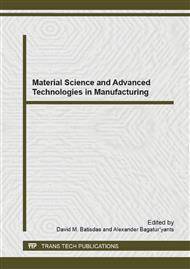[1]
Liu X, Chu P, Ding C. Surface modification of titanium, titanium alloys, and related materials for biomedical applications. Materials Science and Engineering: R: Reports. 2004; 47: 49-121.
DOI: 10.1016/j.mser.2004.11.001
Google Scholar
[2]
Schliephake H, Neukam FW. Bone replacement with porous hydroxyapatite blocks and titanium screw implants: An experimental study. Journal of Oral and Maxillofacial Surgery. 1991; 49: 151-6.
DOI: 10.1016/0278-2391(91)90103-s
Google Scholar
[3]
LeGeros RZ. Properties of osteoconductive biomaterials: Calcium phosphates. Clin Orthop Rel Res. 2002: 81-98.
Google Scholar
[4]
Weng J, Wang M, Chen JY. Plasma-sprayed calcium phosphate particles with high bioactivity and their use in bioactive scaffolds. Biomaterials. 2002; 23: 2623-9.
DOI: 10.1016/s0142-9612(01)00393-3
Google Scholar
[5]
Verestiuc L, Morosanu C, Bercu M, Pasuk I, Mihailescu IN. Chemical growth of calcium phosphate layers on magnetron sputtered HA films. Journal of Crystal Growth. 2004; 264: 483-91.
DOI: 10.1016/j.jcrysgro.2004.01.015
Google Scholar
[6]
Wang D, Chen C, He T, Lei T. Hydroxyapatite coating on Ti6Al4V alloy by a sol-gel method. Journal of materials science Materials in medicine. 2008; 19: 2281-6.
DOI: 10.1007/s10856-007-3338-5
Google Scholar
[7]
Zhang EL, Yang K. Coating of calcium phosphate on biometallic materials by electrophoretic deposition. Trans Nonferrous Met Soc China. 2005; 15: 957-64.
Google Scholar
[8]
Isa NNC, Mohd Y, Yury N. Electrochemical Deposition and Characterization of Hydroxyapatite (HAp) on Titanium Substrate. APCBEE Procedia. 2012; 3: 46-52.
DOI: 10.1016/j.apcbee.2012.06.044
Google Scholar
[9]
Guslitzer-Okner R, Mandler D. Electrochemical Coating of Medical Implants. 2011; 52: 291-342.
DOI: 10.1007/978-1-4614-0347-0_4
Google Scholar
[10]
Narayanan R, Lee H-J, Kwon T-Y, Kim K-H. Anodic TiO2 nanotubes from stirred baths: hydroxyapatite growth & osteoblast responses. Materials Chemistry and Physics. 2011; 125: 510-7.
DOI: 10.1016/j.matchemphys.2010.10.024
Google Scholar
[11]
Brammer KS, Frandsen CJ, Jin S. TiO2 nanotubes for bone regeneration. Trends in Biotechnology. 2012; 30: 315-22.
DOI: 10.1016/j.tibtech.2012.02.005
Google Scholar
[12]
Kokubo T, Takadama H. How useful is SBF in predicting in vivo bone bioactivity. Biomaterials. 2006; 27: 2907-15.
DOI: 10.1016/j.biomaterials.2006.01.017
Google Scholar
[13]
Tao JL, Zhao JL, Tang CC, Kang YR, Li YX. Mechanism study of self-organized TiO2 nanotube arrays by anodization. New J Chem. 2008; 32: 2164-8.
DOI: 10.1039/b808719a
Google Scholar
[14]
Fox K, Tran PA, Tran N. Recent Advances in Research Applications of Nanophase Hydroxyapatite. ChemPhysChem. 2012; 13: 2495-506.
DOI: 10.1002/cphc.201200080
Google Scholar
[15]
Lee K, Jeong Y-H, Brantley WA, Choe H-C. Surface characteristics of hydroxyapatite films deposited on anodized titanium by an electrochemical method. Thin Solid Films. (2013).
DOI: 10.1016/j.tsf.2013.04.077
Google Scholar


